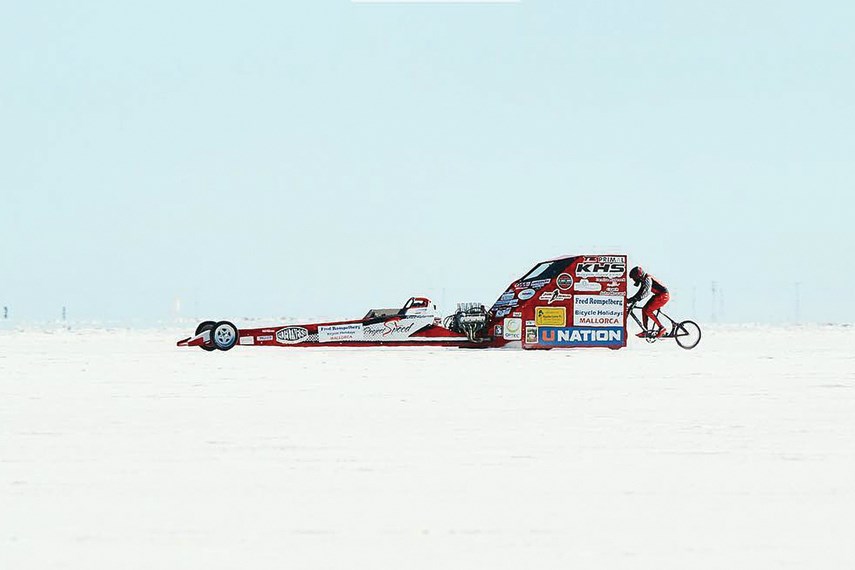Cars and bicycles are frequently at odds.
Whether it’s political wrangling over how to best apportion road use, or physical wrangling at who’s got the right of way, there’s always been an uneasy relationship between two wheels and four. Much ink has been spilled on the subject, probably a little too much of it by me. But I’m not here to take sides today. I’m here to tell you about the woman who just rode her bicycle to an incredible 296 kilometres per hour.
Denise Korenek (Mueller) is a former national champion cyclist from California. A 45-year-old mother of three, Korenek already held the fastest female time at 237 km/h, and had been training hard for the overall motor-paced cycling record.
As anyone who’s ever ridden a bicycle knows, even when you’re flying down the steepest hill, there’s a point at which you just can’t pedal any faster – you’re out of gearing. And, as any cycle commuter knows, the wind always seems to be blowing directly in your face, slowing you down.
Motor-paced cycling addresses these two issues with specially-made bicycles, and drafting. In racing, when one race car is following another very closely, the lead car does all the work of pushing the air out of the way. It’s just physics, but it makes passing and battling for position something of a game of chess.
Thus it is with motor-paced cycling, which replaces the chess with a sort of ballet. The pedals on Korenek’s custom bike have doubled chains and sprockets, with a ratio of 62:12, twice over. Every complete pedal takes her nearly 40 metres; that’s three pumps of the leg to cross a FIFA-sized soccer pitch. Because of the speed, the bicycle has to be fitted with narrow motorcycle wheels.
As if that wasn’t bananas enough, there’s the drafting machine setting the way. It’s a full-blown 1,000 horsepower dragster, fitted with a special cowling to provide more of a windbreak for the closely-following cyclist. Driven by 28-year-old Shea Holbrook, a competitor in the Lamborghini Super Trofeo series with some 27 podium wins in her career, the dragster tows Korenek up to 160 km/h, then drops the tether.
Flashing across the salt flats, Holbrook must vary her speed as Korenek accelerates, working hard not to slow her up, nor drop her out of the slipstream. Further, the salt pan isn’t firm tarmac, but a finely grained surface that can turn slippery or bumpy. Just piloting a normal car with this kind of traction can be tricky.
If this all sounds like a bit of a once-off stunt to get into the Guinness Book of Records, it’s not. Motor-paced cycling has a long, weird, and illustrious history.
More than a century ago, Charles “Mile-a-minute” Murphy swung a leg over the saddle of his bike and began to keep pace with a locomotive of the Long Island Rail company. Murphy had convinced the company that the publicity stunt would be good for their business, so they’d laid down boards in the centre of the track to make a smooth surface for Murphy to ride on. His theory, untested, was that the locomotive’s blocking effect would allow him to ride just as fast as it could go.
In practice, there were several problems. First, the locomotive itself took two passes to hit the mile-a-minute mark (96 km/h). Second, the steam-powered machine was so heavy that it compresses both track and boards, so Murphy was effectively riding a wave of bending wood. And, lastly, have we mentioned that he was chasing down a locomotive? Chunks of cinder, ash, and stone came boiling up around Murphy, burning his face even as the swirling dust choked him. As a grand finale, he crashed into the train as it passed the finish line.
In spite of the pummeling, Mile-a-minute Murphy managed the feat (I mean, the name’s a bit of a give-away), and soon like-minded lunatics were pushing the boundaries ever further. In fact, they even raced behind pacers, using cars, motorcycles, and mopeds to provide a slipstream. Needless to say, this was an incredibly dangerous pursuit. One American racer broke his collarbone 28 times.
Record-setting was, if also testing the edge of what was possible, at least not completely suicidal. In one of surely the most elegant record-setting runs, Frenchman José Meiffret managed a brisk 204 km/h along a German Autobahn, riding behind a Mercedes-Benz 300SL.
A 1979 failed attempt by another Frenchman, the delightfully-named Jean-Claude Rude, incorporated a Porsche 935, a flame-spitting Le Mans champion. The Porsche was fitted with a shroud and some lower metalwork to prevent Monsieur Rude from getting all en flambé, but a tire blowout had him coming up short of Meiffret’s record.
Now, thanks in part to the coaching of John Howard, who set a 268 km/h record in the mid-1990s, we have a new champion. Korenek hit and maintained her pace, long enough to be crowned the new record setter.
You see? Cars and bikes can co-exist after all. Or at least people who love human achievement can find a common way to work together. Isn’t it nice when we all just get along? I’ll borrow a Porsche, and you can look forward to a greatly reduced cycle commute time.
Brendan McAleer is a freelance writer and automotive enthusiast. If you have a suggestion for a column, or would be interested in having your car club featured, please contact him at [email protected]. Follow Brendan on Twitter: @brendan_mcaleer.




